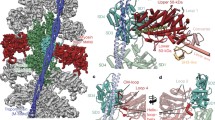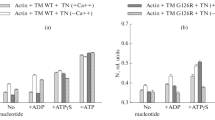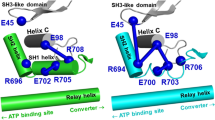Summary
This paper describes a systematic study of crosslinking of skeletal muscle myosin subfragment-1 (S1) and heavy meromyosin (HMM) to F-actin in the rigor state with 1-ethyl-3-[3-(dimethylamino)propyl]carbodiimide (EDC). We followed the time courses of S1 or HMM head crosslinking at various actin:S1 or actin:HMM head molar ratios and the resulting superactivation of ATPase activity. The ATPase activity of the covalent complexes was measured at 0.5 M KCl, where the covalent complexes retain superactivated ATPase activity but the activity of uncrosslinked myosin heads is not activated by actin. S1 crosslinking was slowest at the actin:S1 molar ratio of 1∶1, but faster at larger molar ratios, where more than 80% of added S1 could be crosslinked to actin. In spite of the dependence of crosslinking rate on actin∶S1 ratio, there were two linear correlations between ATPase activity and the extent of S1 crosslinking to actin: one for S1 crosslinked to actin at actin∶S1 molar ratios more than 2.7∶1 and the other for S1 crosslinked at a molar ratio of 1∶1. Extrapolation of the former correlation line to 100% crosslinked S1 gave an ATPase activity of 39 s−1 for actin-S1 covalent complex at 25 °C, whereas that of the other correlation line gave 21 s−1. The latter smaller activity suggests that the interface between actin and S1 in their rigor complexes at a molar ratio of 1∶1 is different from that at molar ratios of more than 2.7∶1. The acto-HMM crosslinking rate depended on the ratio of actin to HMM head, like that of S1 crosslinking to actin. The ATPase activity of crosslinked actin-HMM was, unlike that of actin-S1 covalent complexes, bell-shaped as a function of the crosslinked heads, but chymotryptic conversion of HMM to S1 in the covalent complexes made the bell-shaped characteristics disappear and increased the activity close to that of actin-Sl covalent complexes. These results indicate that some physical constraint imposed on myosin heads suppresses the actin-activated ATPase activity of HMM crosslinked to actin.
Similar content being viewed by others
References
Arata, T. (1984) Chemical crosslinking of myosin subfragment-1 to F-actin in the presence of nucleotide.J. Biochem., Tokyo96, 337–47.
Bechet, J-J & d'Albis, A. (1985) Effect of the filamentous structure of myosin on the actomyosin ATPase activity.Eur. J. Biochem. 146, 117–23.
Chen, T., Applegate, D. &Reisler, E. (1985) Crosslinking of actin to myosin subfragment 1: Course of reaction and stoichiometry of products.Biochemistry 24, 137–44.
Cheung, P. &Reisler, E. (1983) The actomyosin ATPase of synthetic myosin minifilaments, filaments, and heavy meromyosin.J. Biol. Chem. 258, 5040–4.
Duong, A. M. &Reisler, E. (1989) Nucleotide-induced states of myosin subfragment 1 crosslinked to actin.Biochemistry 28, 3502–9.
Eisenberg, E. &Hill, T. L. (1985) Muscle contraction and free energy transduction in biological systems.Science, N.Y.227, 999–1006.
Elzinga, M., Collins, J. H., Kuehl, W. M. &Adelstein, R. S. (1973) Complete amino-acid sequence of actin of rabbit skeletal muscle.Proc. Natn. Acad. Sci. U.S.A.70, 2687–91.
Greene, L. E. (1984) Stoichiometry of actin-S1 crosslinked complex.J. Biol. Chem. 259, 7363–6.
Heaphy, S. &Tregear, R. (1984) Stoichiometry of covalent actin-subfragment 1 complexes formed on reaction with a zero-length crosslinking compound.Biochemistry 23, 2211–4.
Huxley, H. E. (1969) The mechanism of muscular contraction.Science, N.Y.164, 1356–66.
Huxley, A. F. (1974) Review lecture: Muscular contraction.J. Physiol., Lond.243, 1–43.
Laemmli, U. K. (1970) Cleavage of structural proteins during the assembly of the head of bacteriophage T4.Nature, Lond.227, 680–5.
Lowey, S., Slayter, H. S., Weeds, A. G. &Baker, H. (1969) Substructure of the myosin molecule.J. Molec. Biol. 42, 1–29.
Margossian, S. S. &Lowey, S. (1978) Interaction of myosin subfragments with F-actin.Biochemistry 17, 5431–9.
Margossian, S. S. &Lowey, S. (1982) Preparation of myosin and its subfragments from rabbit skeletal muscle.Meth. Enzym. 85, 55–71.
Mornet, D., Pantel, P., Bertrand, R., Audemard, E. &Kassab, R. (1981a) Structure of the actin-myosin interface.Nature, Lond. 292, 301–6.
Mornet, D., Bertrand, R., Pantel, P., Audemard, E. &Kassab, R. (1981b) Proteolytic approach to structure and function of actin recognition site in myosin heads.Biochemistry 20, 2110–20.
Mornet, D., Bertrand, R., Pantel, P., Audemard, E. &Kassab, R. (1981c) Isolation and characterization of the trypsinmodified myosin-S1 derivatives.FEBS Letter 123, 54–8.
Pastra-Landis, S. c., Huiatt, T. &Lowey, S. (1983) Assembly and kinetic properties of myosin light chain isozymes from fast skeletal muscle.J. Molec. Biol. 170, 403–22.
Perry, S. V. (1955) Myosin adenosinetriphosphatase.Meth. Enzym. 2, 582–8.
Pope, B., Wagner, P. D. &Weeds, A. G. (1981) Studies on the actomyosin ATPase and the role of the alkali light chains.Eur. J. Biochem. 117, 201–6.
Rouayrenc, J. F., Bertrand, R., Kassab, R., Walzthony, D., Bahler, H. &Walliman, T. (1985) Further characterization of the structural and functional properties of the crosslinked complex between F-actin and myosin S-1.Eur. J. Biochem. 146, 391–401.
Stein, L. A., Greene, L. E., Chock, P. B. &Eisenberg, E. (1985) Rate-limiting step in the actomyosin adenosinetriphosphatase cycle: Studies with myosin subfragment 1 crosslinked to actin.Biochemistry 24, 1357–63.
Sutoh, K. (1982) Identification of myosin-binding sites on the actin sequence.Biochemistry 21, 3654–61.
Sutoh, K. (1983) Mapping of actin-binding sites on the heavy chain of myosin subfragment 1.Biochemistry 22, 1579–85.
Taussky, H. H. &Shorr, E. (1953) A microcolorimetric method for the determination of inorganic phosphorus.J. Biol. Chem. 202, 675–85.
Tawada, K. &Kawai, M. (1990) Covalent crosslinking of single fibres from rabbit psoas increases oscillatory power.Biochys. J. 57, 643–7.
Tawada, K. &Kimura, M. (1986) Stiffness of carbodiimidecrosslinked glycerinated muscle fibres in rigor and relaxing solutions at high salt concentrations.J. Musc. Res. Cell Mot. 7, 339–50.
Wagner, P. D. &Weeds, A. G. (1977) Studies on the role of myosin alkali light chains.J. Molec. Biol. 109, 455–73.
Wagner, P. D., Slater, C. S., Pope, B. &Weeds, A. G. (1979) Studies on the actin activation of myosin subfragment-1 isoenzymes and the role of myosin light chains.Eur. J. Biochem. 99, 385–94.
Weeds, A. G. &Taylor, R. S. (1975) Separation of subfragment-1 isoenzymes from rabbit skeletal muscle myosin.Nature, Lond.257, 54–6.
Weeds, A. G. &Pope, B. (1977) Studies on the chymotryptic digestion of myosin. Effects of divalent cations on proteolytic susceptibility.J. Molec. Biol. 111, 129–57.
Yamamoto, K. &Sekine, T. (1986) Difference between subfragment-1 and heavy meromyosin in their interaction with F-actin.J. Biochem., Tokyo99, 199–206.
Yamamoto, K. (1990) Shift of binding site at the interface between actin and myosin.Biochemistry 29, 844–8.
Young, D. M., Himmelfarb, S. &Harrington, W. F. (1965) On the structural assembly of the polypeptide chains of heavy meromyosin.J. Biol. Chem. 240, 2428–36.
Author information
Authors and Affiliations
Rights and permissions
About this article
Cite this article
Huang, YP., Kimura, M. & Tawada, K. Covalent crosslinking of myosin subfragment-1 and heavy meromyosin to actin at various molar ratios: Different correlations between ATPase activity and crosslinking extent. J Muscle Res Cell Motil 11, 313–322 (1990). https://doi.org/10.1007/BF01766669
Received:
Accepted:
Issue Date:
DOI: https://doi.org/10.1007/BF01766669




